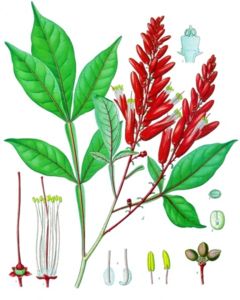| subsp. var.
|
|

|
| Habit:
|
|
[[Category:]]
|
| Height:
|
⇕
|
to
|
| Width:
|
⇔
|
to
|
|
|
cm
|
|
| Height:
|
⇕
|
cm to The wikipage input value is empty (e.g. <code>SomeProperty::, [[]]</code>) and therefore it cannot be used as a name or as part of a query condition.
|
| Width:
|
⇔
|
The wikipage input value is empty (e.g. <code>SomeProperty::, [[]]</code>) and therefore it cannot be used as a name or as part of a query condition. to The wikipage input value is empty (e.g. <code>SomeProperty::, [[]]</code>) and therefore it cannot be used as a name or as part of a query condition.
|
| Lifespan:
|
⌛
|
|
| Origin:
|
✈
|
|
| Poisonous:
|
☠
|
|
| Bloom:
|
❀
|
|
|
| Exposure:
|
☼
|
|
| Water:
|
◍
|
|
| Features:
|
✓
|
|
| Hidden fields, interally pass variables to right place
|
|
|
| Minimum Temp:
|
☃
|
°F
|
| USDA Zones:
|
|
to
|
| Sunset Zones:
|
|
|
| Flower features:
|
❀
|
|
|
|
|
| Standard Cyclopedia of Horticulture
|
|
Quassia (from an aboriginal name). Simarubaceae. Trees, sometimes cultivated in the warmhouse.
Leaves alternate, pinnate; lfts. alternate, entire, coriaceous: panicles axillary and terminal, elongated,branched; fls. subcymose-dioecious; calyx small, 5- lobed; petals 5; stamens 10 in the male, rudimentary in the female fls.; ovary sunken in the disk, deeply 5- parted: fr. 1-5 spreading sessile drupes.—About 5 species, Trop. Amer. and Trop. Afr.
The above text is from the Standard Cyclopedia of Horticulture. It may be out of date, but still contains valuable and interesting information which can be incorporated into the remainder of the article. Click on "Collapse" in the header to hide this text.
|
| Quassia {{{status}}} Fossil range: {{{fossil_range}}}
|

Quassia amara
|
| Plant Info
|
| Common name(s):
|
|
{{{common_names}}}
|
| Growth habit:
|
|
{{{growth_habit}}}
|
| Height:
|
⇕
|
{{{high}}}
|
| Width:
|
⇔
|
{{{wide}}}
|
| Lifespan:
|
⌛
|
{{{lifespan}}}
|
| Exposure:
|
☼
|
{{{exposure}}}
|
| Water:
|
☂
|
{{{water}}}
|
| Features:
|
❀
|
{{{features}}}
|
| Poisonous:
|
☠
|
{{{poisonous}}}
|
| Hardiness:
|
❆
|
{{{hardiness}}}
|
| USDA Zones:
|
|
{{{usda_zones}}}
|
| Sunset Zones:
|
|
{{{sunset_zones}}}
|
|
| Scientific classification
|
| Domain:
|
{{{domain}}}
|
| Superkingdom:
|
{{{superregnum}}}
|
| Kingdom:
|
Plantae
|
| Subkingdom:
|
{{{subregnum}}}
|
| Superdivision:
|
{{{superdivisio}}}
|
| Superphylum:
|
{{{superphylum}}}
|
| Division:
|
Magnoliophyta
|
| Phylum:
|
{{{phylum}}}
|
| Subdivision:
|
{{{subdivisio}}}
|
| Subphylum:
|
{{{subphylum}}}
|
| Infraphylum:
|
{{{infraphylum}}}
|
| Microphylum:
|
{{{microphylum}}}
|
| Nanophylum:
|
{{{nanophylum}}}
|
| Superclass:
|
{{{superclassis}}}
|
| Class:
|
Magnoliopsida
|
| Sublass:
|
{{{subclassis}}}
|
| Infraclass:
|
{{{infraclassis}}}
|
| Superorder:
|
{{{superordo}}}
|
| Order:
|
Sapindales
|
| Suborder:
|
{{{subordo}}}
|
| Infraorder:
|
{{{infraordo}}}
|
| Superfamily:
|
{{{superfamilia}}}
|
| Family:
|
Simaroubaceae
|
| Subfamily:
|
{{{subfamilia}}}
|
| Supertribe:
|
{{{supertribus}}}
|
| Tribe:
|
{{{tribus}}}
|
| Subtribe:
|
{{{subtribus}}}
|
| Genus:
|
Quassia
L.
|
| Subgenus:
|
{{{subgenus}}}
|
| Section:
|
{{{sectio}}}
|
| Series:
|
{{{series}}}
|
| Species:
|
{{{species}}}
|
| Subspecies:
|
{{{subspecies}}}
|
|
| [[{{{diversity_link}}}|Diversity]]
|
| {{{diversity}}}
|
| Binomial name
|
{{{binomial}}}
|
| Trinomial name
|
{{{trinomial}}}
|
| Type Species
|
{{{type_species}}}
|
| Species
|
| See text.
|
[[Image:{{{range_map}}}|{{{range_map_width}}}|]]
|
| Synonyms
|
| {{{synonyms}}}
|
Quassia is a genus in the family Simaroubaceae. Its size is disputed; some botanists treat it as consisting of only one species, Quassia amara from [tropical] South America, while others treat it in a wide circumscription as a pantropical genus containing up to 40 species of trees and shrubs.
Broader treatments of the genus include the following and other species:

